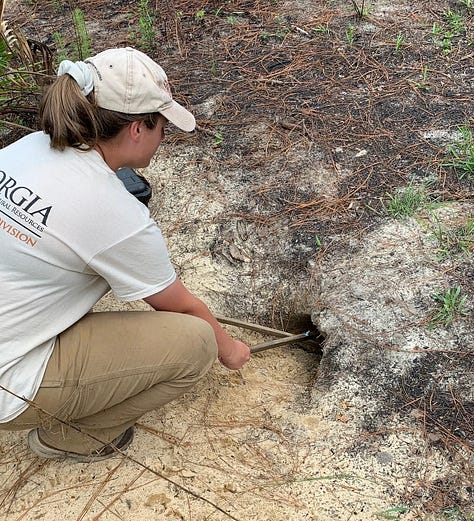Meet a Gen Z Environmentalist Who Goes for the Gophers
An interview with recent college graduate, Sam Jenkins, who likes to consider nature's interconnectivity.

Our planet has just recorded its hottest July on record. No matter where you call home, you’ve likely experienced the uncomfortable heat, the stifling humidity. I don’t go outside as often these days and am not doing as much community science as usual. However, others who love the natural world are keeping up the pace because the job demands it, and the work needs to be done now. This week, I’ll introduce you to one of those folks, an impressive member of Generation Z. Sam Jenkins, an Atlanta-area environmentalist, is toiling this hot summer with little complaint, all in the interest of science and nature.
Jenkins, a recent graduate of The University of the South, has a brand-new B.S. degree in biology and a brand-new job to go with it. I met him in June when a friend told me about how he had found a rare gopher frog in the wild near Tifton, Ga. Gopher frogs are among the 100 most endangered species in the world, so the discovery was consequential. When I got a chance to interview him, I jumped right in with my frog questions:
“I know UGA breeds and releases some gopher frogs in Georgia. Are you sure it wasn’t one of those?” I asked.
“No, we think it was a purely wild one. The area where we saw him was far, far away from any of the release areas. It was exciting. Unexpected,” he said.
I’d been curious about gopher frogs for more than a year, so it was great to see his photo and confirm that at least one is thriving in Georgia. As I talked longer to Jenkins, I realized that his gopher tortoise stories were even more interesting that the frog discovery.
Here are highlights our our talk:
What is your summer job?
Sam: “I’m currently a part-time employee for the Department of Natural Resources (DNR) wildlife resource division working specifically for the gopher tortoise survey crew. A gopher tortoise is a land turtle that has front feet like shovels that allow it to dig deep burrows underground. For the survey, I work four days a week with a team which is locating and recording gopher tortoises and their burrows within designated protected lands. These data is used to determine the strength and distribution of these tortoises throughout their geographic range. This is used to determine the species conservation status as well as informing developers of their presence.”

How exactly do you see the tortoises?
Sam: “Technology helps. We use an instrument which has a 15-20-foot flexible scope that can be threaded down into the burrow to take pictures. There’s a little camera on the end.”



Where in Georgia are you working?
Sam: “We are at the Alapaha Wildlife Management area near Tifton, Ga. This specific property is owned by the Department of Defense, which is legally required to provide a population survey of the tortoises on their land since the tortoises are a threatened species and are often overlooked on these military sites.”
This summer’s a steamy one. How has it been working outside during the hottest July in the history of the planet?
Sam: “The heat is definitely a battle with temps in the mid-90s into triple digits. Some days getting back into the A.C. at our bunk house is one of the best parts of the day. It’s tough being in this environment all day. The heat and bugs and prickly things are not ideal but that’s just a part of the job. We keep our spirits up by trying to joke and lighten the mood as we work.”
I’d need Chris Rock to tell the jokes to stay cheerful during a 100-degree workday. What else keeps you going?
Sam: “We see some pretty cool critters out in the field. So that’s great, and I also like seeing how long and intricate the burrows can be. It is pretty cool. One important benefit to gopher tortoises is that their burrows often make a home for other critters who use these spaces to avoid predators or to regulate body temperature.”

Part 2 of this interview will be published next week. That section will include a picture of a huge diamondback rattlesnake Jenkins encountered, his conservation book recommendations, and a gallery of photos the crew has taken in the longleaf pine ecosystem they’re working in this summer.
Upcoming:
The Great Southeast Pollinator Census will be Aug. 18 and 19. Go to the website and watch the cute video that teaches you how to participate in this community science project.
Index of all topics and projects I’ve covered this year in The Everyday Scientist. Maybe you’ll find the one that is perfect for you.





I wanted to become a Forest Forest Ranger when I was in school because I love nature so much. A little late now so I get my fix with The Everyday Scientist! Really enjoy all the stories and look forward to part 2 next week. Go Sam!
Way to go Sam!!!